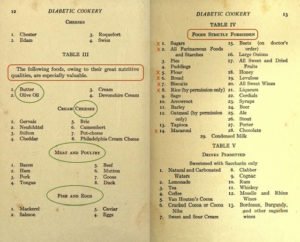Many people today suffer with some type of peripheral neuropathy – peripheral, meaning outer — so your hands and feet, and neuropathy – a condition of the nerves resulting in altered sensation or feeling. Many people refer to this symptom as numbness, tingling, pins & needles, or other such terms; it basically means that nerve endings are generally not functioning as they should, due to some impact like high glucose, poor nutrition, hypothyroidism, anemia, poor circulation, smoking, or other causes.
That said, let’s look at a few things that might help identify causes of peripheral neuropathy. The first 2 questions I always ask when these symptoms are reported:
The best first step to identifying possible causes of the problem is a thorough lab review; some of you have seen my lab graphic below, and I highly recommend that all of these tests be performed for a complete and comprehensive evaluation.

The next best step is to have someone interpret these results with a more FUNCTIONAL perspective; normal lab reference ranges are for healthy people. Healthy people do NOT report symptoms. Any time a patient reports symptoms, lab ranges should be taken with a “grain of salt” and evaluated differently.
1. What glucose levels are you seeing? 2. Have you ever been a smoker?
These 2 MOST important questions help rule in or out certain things to consider. If the patient is not a KNOWN diabetic, then it’s essential to obtain insulin and A1c levels; diabetes is almost always diagnosed because of symptoms impacting life, and the patient has no clue of the diabetes yet. A Hgb A1c of 5.4 or so CAN contribute to the development of neuropathy — yes, diabetic complications often occur years before a patient is diagnosed with the condition. In this link, researchers found cardiovascular symptoms/risks associated with A1c levels greater than 5.3%. https://pmc.ncbi.nlm.nih.gov/articles/PMC10095266/
How can we believe that mild elevations in glucose that impact the heart might also impact the nervous system? Because of the extremely sensitive nature of BOTH systems’ cells and processes.
Sometimes in clinic, I have patients with REALLY good A1c levels, but insulin levels around 7-8 mCu/mL, and some of these patients ALSO report numbness, tingling, weakness in hands and feet — so even though their GLUCOSE looks good, the insulin is driving some symptoms. We also can look at triglycerides, HDL, and various inflammation markers to help us understand some people’s symptoms. Triglycerides above 90-100 often create symptoms, similar to elevated glucose – both of these molecules are thick and sticky. In the tiniest blood vessels called capillaries, these thick, sticky molecules can create MICRO-clots, even if temporary, reducing blood flow to hands and feet. Feet are more susceptible for sure, b/c they are further away from the heart and the main circulatory pumping system AND gravity will impact the blood flow.
How does gravity impact blood flow? What goes down must come up, right? WRONG. Fluid, like blood, is easily falling with every heartbeat, down into legs and feet. When the blood contains thick, sticky molecules like glucose and triglycerides and/or inflammatory molecules, these larger substances can fall b/c gravity pulls them downward. BUT, these same thick, sticky, HEAVY molecules and inflammatory sediment – like ferritin or gouty crystals – can be VERY difficult to move UPHILL. What fluid do you know that runs uphill? None. Muscle contractions will help push fluid up in the veins, but sedentary people have a hard time with this – they aren’t moving walking, exercising as much as others. So how do we move these sticky molecules from the feet back into the torso where the heart, kidneys, and lungs can better rid the body of them? Elevate. Elevate. ELEVATE.
Get feet HIGHER than your heart — a typical recliner is NEVER sufficient unless you are adding pillows underneath your feet. Many people will lay on the floor and rest feet upon the wall or on a chair or sofa to get them high enough to drain properly. Ideally, elevating feet 2-4 times a day for about 15 minutes each time will help move fluid around very effectively. This method is helpful for structural issues, but not the chemical ones — lowering glucose, insulin, triglycerides, and inflammation will slow/stop the thick sticky molecules from forming. Eliminating grains and carbs is absolute key to the possible restoration of nerve function in hands and feet.
Smoking/vaping will directly impact nerve endings, reducing blood flow structurally. This problem is rarely reversible, unless the smoking/vaping is stopped early on. Once the person continues this habit for years, permanent damage to the blood vessels occurs, b/c the toxins literally close the capillaries – cutting off blood supply to that area of the body. Have you ever noticed a smoker’s fingertips? They’r often flattened or “clubbed” b/c of the reduced blood flow to the fingertips. This is not reversible.
Other problems that contribute to peripheral neuropathy: hypothyroidism – get that Free T3 above 3.5 ng/dL; and anemia/low iron/low ferritin. Since ferritin is used by the RBC as hemoglobin, it is extremely important to blood flow. If ferritin level falls below 45-50 ng/mL, circulation is impaired. While it sounds like it should be a simple fix, it’s really not. Iron supplements can be toxic when taken long-term, and many of the mainstream iron supplement cause severe side effects, making it quite challenging to remain compliant with taking them. Iron supplementation also requires some cofactors to optimize absorption: Vitamin C and Vitamin D are essential to good iron metabolism. Vit D has its own set of cofactors, adding to the complexity. This article has more info about D and its cofactors: https://joyfulhearthousecalls.com/what-is-vitamin-d-why-do-i-need-it/
Other nutrient deficits that often contribute to neuropathy include the B vitamins; these are a GROUP of vitamins that all work together to support the nervous system and aid in various other body processes. Some of the B vitamins aid in iron absorption, so see how all the nutrients really depend on each other? No one supplement can or should be taken in isolation, by itself; they all should be taken in between bites of food – preferably fatty food b/c some of the require fat for optimal absorption and use. Low fat diets can contribute to neuropathy b/c fat intake is essential for myelin sheath support – the cover or envelope around nerve endings. Low protein intake can contribute to poor cell growth and development. Low sodium or magnesium levels might contribute as well. Nutrient density is the key to true health.
There are some other contributors to neuropathy, but these are the most common; Lyme disease EBV flares, other autoimmune conditions, and a few other chronic illnesses can cause nerve pain, numbness, or tingling. But once the major causes are addressed, even these rarer situations often improve.
NOTICE: This content is for informational and educational purposes only. It is not intended to provide medical advice or to take the place of medical advice or treatment from a personal health care professional. All viewers of this content are advised to consult their own qualified health professionals regarding specific health questions. Neither Joyful Heart House Calls, LLC, or KetoNurses or the publisher of this content takes responsibility for possible health consequences of any person or persons reading or following the information in this educational content. All viewers of this content, especially those taking prescription or over-the-counter medications, should consult their medical providers before beginning any nutrition, supplement or lifestyle program.



